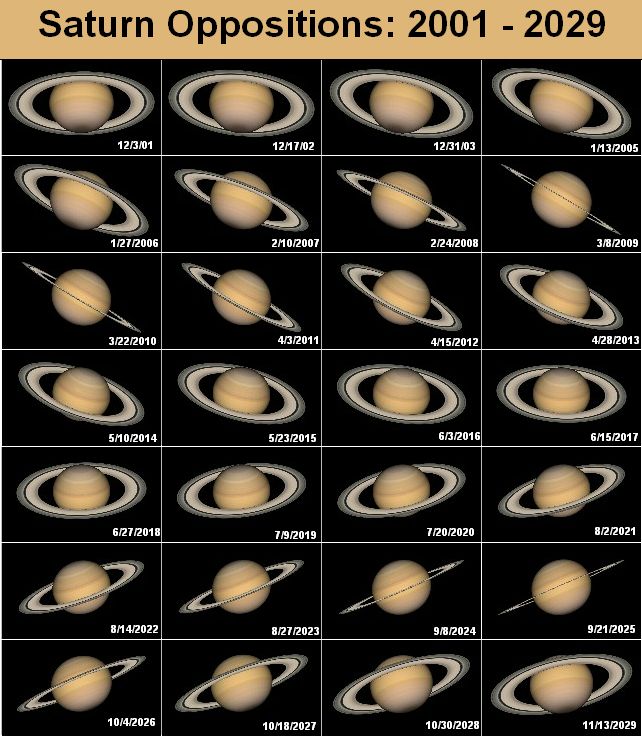On any given night, you can see Saturn's rings with a small telescope or even binoculars.
Granted, some nights are better than others, but even on a "bad" night seeing Saturn has an amazingly high Wow-ratio:
(more than anything I've tried to share in my life. People overwhelmingly love Saturn at first glance. Kate Bush is equally amazing, but only 0.005% are amazed by her at first listen)
Saturn's Rings are Disappearing!!!!
I saw this click-bait headline. Yes. Saturn's rings are diminishing in appearance until March 2025 when they won't be visible at all!!!
But they'll be back! It's all a part of the orbital optical illusion as Saturn swings along it long 29-year orbit.
The rings are currently, sadly, in the part of the cycle where they appear flatter/thinner due to its tilt in its orbit. We'll see less and less of the rings until March 2025 when they'll be invisible. Then they'll start the cycle over again, broading up to a maximum of 27 degrees a quarter of it's year later (2032).
 |
https://commons.wikimedia.org/wiki/File:Saturnoppositions-animated.gif |
The animation above is the variation we'd see in the Saturn's tilt we'd see if we watched it over the course of its year (the Saturn year is 29.5 earth years. From flat to full takes a quarter of that, a little over seven years. Note that it's an illusion from persective: the tilt does not change orientation, it appears to based on it's position relative to the sun. Exactly like our seasons.
Saturn near Opposition
Saturn's Oppostion - when the earth is closest to it and it appears biggest and brightest - occurred this year (2023) on August 27.
By definition, Saturn will be Opposite the Sun, meaning it rises when the sun goes down.
Celestial Targets seldom look good when they're close to the horizon, so give it 90 minutes or two hours to get a good look, Targets typically look best when they are obscured by the least amount of atmosphere - directly over head (rare) or passing through the meridian (the line running south to north through the local "up". Think am and pm (ante-meridian and post-meridian).
In addition to the typical outer planets looking bigger and brighter at opposiition, Saturn has a fleeting mythical effect known as the Seelinger Effect when, for a few hours around opposition, the rings' icy particles reflect the sunlight extra brightly. It's like the Green Flash, you can see it if you're lucky - though with the Green Flash you get over 300x more chances to see it.
Saturn after Oppostion
After Opposition, Earth moves away from Saturn, making it looking continually smaller until it appears to "disappear" behind the Sun. The good news is that Saturn is a gas giant, so it's BIG. It always looks good. And, after Opposition, it continues is westward march toward the Sun. This means it is observable immediately after sunset (at opposition you have to wait several hours before it clears the long murky air near the horizon).

source: https://commons.wikimedia.org/wiki/File:Saturnoppositions.jpg
here's a link to a chart of its tilt as seen from earth: https://images.app.goo.gl/6dE3mvQBe4S7CpPp6